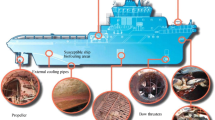Abstract
An interpretation of the relation between the electric field and the applied current for cathodic protection is investigated using a boundary element method simulation. Also, a conductivity-difference environment is set for the interface influence. The variation of the potential distribution is increased with the increase of the applied current and the conductivity difference due to the rejection of the current at the interface. In the case of the electric field, the tendencies of the increasing rate and the applied currents are similar, but the interface influence is different according to the directional component and field type (decrease of Ez and increases of Ex and Ey) due to the directional difference between the electric fields. Also, the change tendencies of the electric fields versus the applied current plots are affected by the polarization curve tendency regarding the polarization type (activation and concentration polarizations in the oxygen-reduction and hydrogen-reduction reactions). This study shows that the underwater electric signature is determined by the polarization behavior of the materials.













Similar content being viewed by others
References
J.J. Holmes, Reduction of a Ship’s Magnetic Field Signature (Morgan & Claypool Publishers, Williston, 2008), pp. 55–72
J.J. Holmes, Modelling a Ship’s Ferromagnetic Signatures, 1st edn. (Morgan & Claypool Publishers, Williston, 2007), pp. 33–48
J.J. Holmes, Exploitation of a Ship’s Magnetic Field Signatures, 1st edn. (Morgan & Claypool Publishers, Williston, 2006), pp. 12–22
J.C. Hubbard, S.H. Brooks, B.C. Torrance, UDT 64, 480 (1996)
R. Donati, J.P. Le Cadre, IRR Proc. Radar Sonar Navig. 149, 221 (2002)
A. Guibert, O. Chadebec, J.L. Coulomb, C. Rannou, IEEE Trans. Magn. 12, 1828 (2009)
J. Wu, S. Xing, C. Liang, L. Lu, Y. Yan, Adv. Eng. Softw. 42, 902 (2001)
M. Fogiel, The Electromagnetics Problem Solver (Research and Education Association, New Jersey, 2000), pp. 77–83
E.S. Diaz, R. Adey, J. Baynham, Optimisation of ICCP Systems to Minimise Electric Signatures, MARELEC, Stockholm, Sweden, (2001), pp. 1–17
R. Adey, J. Baynham, Predicting Corrosion Related Electrical and Magnetic Fields Using BEM (UDT, 2000)
D.E. Santana, R. Adey, Bound. Elem. 24, 1 (2003)
M. Verney, S. Bailey, M. Siddal, J. Soc. Underw. Tech. 42, 51 (1999/2000)
P. Traverso, E. Canepa, Ocean Eng. 87, 10 (2014)
C. Roder, M.L. Berumen, J. Bouwmeester, E. Papathanassiou, A. Al-Suwailem, C.R. Voolstr, Sci. Rep. 3, 2802 (2013)
A.S. Inan, A.C. Fraser-Smith, O.G. Villard, Radio Sci. 21, 409 (2016)
X.C. Lu, Acoust. Technol. 23, 117 (2004)
R.Y. Yue, Z.X. Tian, Ship Sci. Tech. 31, 21 (2009)
Y. Ruiyng, H. Ping, Z. Jing, IEEE/OES China Ocean Acoust. 10, 1109 (2016)
A. Guibert, O. Chadebec, J.-L. Coulomb, C. Rannou, IEEE T. Magn. 45, 1828 (2009)
B. Grosgogeat, L. Reclaru, M. Lissac, F. Dalard, Biomaterials 20, 933 (1999)
J.-P. Celis, P. Ponthiaux, F. Wenger, Wear 261, 939 (2006)
J.-H. Kim, Y.-S. Kim, J.-G. Kim, Ocean Eng. 115, 149 (2016)
M. Varney, S. Bailey, M. Siddall, Underw. Technol. 24, 51 (1999/2000)
H.-J. Chung, C.-S. Yang, G.-W. Jeung, J.-J. Jeon, D.-H. Kim, IEEE Trans. Magn. 47, 1282 (2011)
D.A. Jones, Principle and Prevention of Corrosion, 2nd edn. (Prentice Hall, New Jersey, 1996), pp. 235–248
Acknowledgements
This work was supported by the Agency for Defense Development (No. UD150010DD).
Author information
Authors and Affiliations
Corresponding author
Rights and permissions
About this article
Cite this article
Kim, YS., Ko, SJ., Lee, S. et al. Computational Interpretation of the Relation Between Electric Field and the Applied Current for Cathodic Protection Under Different Conductivity Environments. Met. Mater. Int. 24, 315–326 (2018). https://doi.org/10.1007/s12540-018-0034-6
Received:
Accepted:
Published:
Issue Date:
DOI: https://doi.org/10.1007/s12540-018-0034-6




